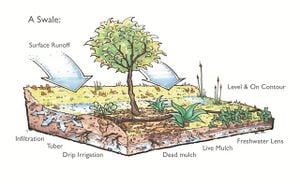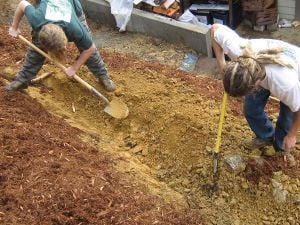
Swales, also know as bioswales, are shallow trough-like depressions created to carry water during rain or snow melt. They are rapidly becoming a staple in the design of sustainable landscapes due to their many advantages. Many governments are beginning to require bioswales along with other "best management practices"
Uses[edit | edit source]

Swales can re-direct water away from sensitive areas, such as a basement home or water-sensitive plants. They act as a water filter with soil as the medium and stores water from rainstorms and snow runoff until it is filtered through the soil. After the water filters through the soil, it will recharge the local groundwater.
Swales covered or partially covered with grass can be used as walking paths. However, they will be unsuitable during wet periods as they will be underwater, or soft and muddy.
Types of swale[edit | edit source]
Dry swales are above the groundwater, such that they only hold water above the soil surface temporarily.
Wet swales intersect the groundwater, and behave almost like linear constructed wetlands. Plant choice differs accordingly, compared to dry swales.
There are other techniques similar to swales. A swale can be considered a kind of bioretention cell or rain garden, but shallower, in a channel shape, and covered with grass or other plants.
Design recommendations[edit | edit source]
- Single swales can not treat areas greater than 10 acres/4 hectares.
- The swale should have a treatment area larger than 4% of the impervious surface it treats.
- The treatment depth should not exceed 2/3 the depth of the grass in the swale
- The dimensions of the swale should be checked with Manning's equation and a value of.25 for "Manning's n"
- Care should be taken in the design of the inlet and outlet of the swale
- A 6% down slope grade is ideal to insure that the velocity of the water in the swale does not become excessive.
- The side slopes of the swale should not exceed 3 to 1 (three feet/90 centimeter over for every one foot/thirty centimeter down)
- The swale should have a maximum treatment width of 10 feet/3 meter, parallel swales should be used if greater widths are necessary.
Advantages and disadvantages[edit | edit source]
Advantages:
- A means of groundwater recharge, a favorite of permaculture pioneer Bill Mollison.
- Asthetically pleasing
- They treat water flowing through them
- Oils in the water are trapped in foliage and sand, where they break down over time.
- Sediments are trapped and filtered out
Disadvantages:
- Impractical on steep slopes.
- Requires thick vegetation.
Techniques for increasing capacity[edit | edit source]
If the soil is very permeable, the runoff infiltrates easily. If not, either an underdrain may be used, or holding capacity increased, or it is accepted that above a certain level of rainfall runoff, overflow will occur.
If an underdrain is used, the emphasis is then on stormwater management and it should be expected that the potential for groundwater recharge is greatly reduced. The underdrain would be a perforated pipe in a gravel layer below the bottom of the swale.
Another way to reduce the likelihood of this level of runoff is to increase the absorption capacity of upstream parts of the catchment, through improvements in soil, and/or adding more retention devices such as additional swales (perhaps small ones) and rain gardens.
See also[edit | edit source]
External links[edit | edit source]
- How to dig Swales - wikiHow
- Wikipedia:Swale (geographical feature)
- Virginia DCR Stormwater Design Specification No. 10 Dry Swales v1.5 – DRAFT, July 1, 2009 Very detailed, describing dry swales using underdrains. (Last accessed 4 November 2009. Please replace link with later/final version when it becomes available.)
- Save the Swales - WHY MANAGE RUNOFF? (the site of a local government in Florida).
- Alameda County Stormwater Technical Guidance has more details for the design of Bioswales and other best management practices.